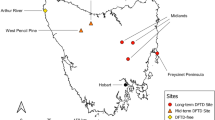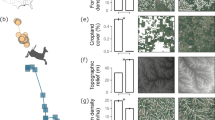Abstract
This paper presents a stylized bioeconomic model of hunter-gatherer foraging effort designed to study the process of intensification on open-access resources. A critical insight derived from the model is that the very success of an adaptation at the level of an individual forager group can create system-level vulnerabilities that subsequently feed back to cause emergent social change. The model illustrates how the intensification of harvest time by individuals within a habitat creates a forager-resource system that becomes vulnerable to perturbations. When the system is vulnerable, it is characterized by two resource harvest equilibria: a sustainable, low-effort equilibrium and a degraded, high-effort equilibrium. In this situation, the forager-resource system can be shocked back and forth between these different equilibria by perturbations, generating considerable risk for foragers. We use the model to isolate the ecological conditions under which the instability of the system generates the risk that foragers will experience a shortfall of resources, and we suggest a mechanism that might lead foragers to adopt social institutions that regulate who can access a habitat as an adaptive response. As an illustration of the potential utility of the insights drawn from the model, comparisons are made with a substantial ethnographic data set.






Similar content being viewed by others
References
Anderies, J. M. (1998). Culture and human agro-ecosystem dynamics: the Tsembaga of New Guinea. Journal of Theoretical Biology, 192, 515–530.
Anderies, J. M. (2003). Economic development, demographics, and renewable resources: a dynamical systems approach. Environment and Development Economics, 8, 219–246.
Anderies, J. M. (2006). Robustness, institutions and large-scale change in socio-ecological systems: the Hohokam of the Phoenix Basin. Journal of Institutional Economics, 2, 133–155.
Anderies, J. M., Jannsen, M. A., & Walker, B. H. (2002). Grazing management, resilience, and the dynamics of a fire-driven rangeland system. Ecosystems, 5, 23–44.
Baker, M. J. (2003). An equilibrium conflict model of land tenure in hunter-gatherer societies. Journal of Political Economy, 111, 124–173.
Bender, B. (1978). Gatherer to farmer: a social perspective. Journal of World Archaeology, 10, 204–222.
Bettinger, R. L. (1991). Hunter-gatherers: Archaeological and evolutionary theory. New York: Plenum.
Bettinger, R. L. (1999). From traveler to processor: Regional trajectories of hunter-gatherer sedentism in the Inyo-Mono Region, California. In B. R. Billman & G. M. Feinman (Eds.), Settlement pattern studies in the Americas: Fifty years since Viru (pp. 39–55). Washington: Smithsonian.
Bettinger, R. L., & Baumhoff, M. A. (1982). The Numic spread: Great Basin cultures in competition. American Antiquity, 47, 487–503.
Binford, L. R. (1983). In pursuit of the past: Decoding the archaeological record. New York: Thames and Hudson.
Binford, L. R. (1999). Time as a clue to cause? Proceedings of the British Academy, 101, 1–35.
Binford, L. R. (2001). Constructing frames of reference: An analytical method for archaeological theory building using hunter-gatherer and environmental data sets. Berkeley: University of California Press.
Brander, J. A., & Taylor, M. S. (1998). The simple economics of Easter Island: A Ricardo-Malthus model of renewable resource use. American Economic Review, 88, 119–138.
Cashdan, E. (1983). Territoriality among human foragers: Ecological models and an application to four Bushman groups. Current Anthropology, 24, 47–66.
Charnov, E. L. (1976). Optimal foraging, the marginal value theorem. Theoretical Population Biology, 9, 129–136.
Charnov, E. L., Orians, G. H., & Hyatt, K. (1976). Ecological implications of resource depression. American Naturalist, 10, 247–259.
Clark, C. W. (1976). Mathematical bioeconomics: The optimal management of renewable resources. New York: Wiley.
Clark, C. W., & Mangel, M. (2001). Dynamic state models in ecology. New York: Oxford University Press.
Cohen, M. N. (1977). The food crisis in prehistory. New Haven: Yale University Press.
Cohen, M. N. (2009). Introduction: rethinking the origins of agriculture. Current Anthropology, 50, 591–595.
Cowgill, G. L. (1975). On the causes and consequences of ancient and modern population changes. American Anthropologist, 77, 505–525.
Dielman, T. E. (2001). Applied regression analysis. Pacific Grove: Brooks and Cole.
Dyson-Hudson, R., & Smith, E. A. (1978). Human territoriality: an ecological reassessment. American Anthropologist, 80, 21–41.
Ermentrout, B. (2006). XPPAUT 5.96 (Linux-Ubuntu distribution).
Gordon, H. S. (1954). The economic theory of a common property resource: the fishery. Journal of Political Economy, 62, 124–42.
Grove, M. (2009). Hunter-gatherer movement patterns: causes and constraints. Journal of Anthropological Archaeology, 28, 222–233.
Hassell, M. P., & Varley, G. C. (1969). New inductive population model for insect parasites and its bearing on biological control. Nature, 223, 1133–1137.
Hayden, B. (1995). A new overview of domestication. In: D. T. Price & A. B. Gebaure (Eds.), Last hunters–first farmers: New perspectives on the prehistoric transition to agriculture (pp. 273–299). Santa Fe: School of American Research Press.
Holt, R. D., & Kimbrell, T. (2007). Foraging and population dynamics. In D. W. Stephens, J. S. Brown, & R. C. Ydenberg (Eds.), Foraging: Behavior and ecology (pp. 365–395). Chicago: University of Chicago Press.
Janssen, M. A., Kohler, T. A., & Scheffer, M. (2003). Sunk-cost effects and vulnerability to collapse in ancient societies. Current Anthropology, 44, 722–728.
Keeley, L. H. (1988). Hunter-gatherer economic complexity and population pressure: a cross-cultural analysis. Journal of Anthropological Archaeology, 7, 373–411.
Keeley, L. H. (1995). Protoagricultural practices among hunter-gatherers: a cross-cultural survey. In D. T. Price & A. B. Gebaure (Eds.), Last hunters-first farmers: New perspectives on the prehistoric transition to agriculture (pp. 243–272). Santa Fe: School of American Research Press.
Kelly, R. L. (1995). The foraging spectrum: Diversity in hunter-gatherer lifeways. Washington: Smithsonian Institution Press.
Lee, C. T., & Tuljapurkar, S. (2008). Population and prehistory I: food-dependent population growth in constant environments. Theoretical Population Biology, 73, 473–482.
MacArthur, R. H. (1972). Geographical ecology: Patterns in the distribution of species. New York: Harper and Row.
MacArthur, R. H., & Pianka, E. R. (1966). On optimal use of a patchy environment. American Naturalist, 100, 603–609.
May, R. M. (1973). Stability and complexity in model ecosystems. Princeton: Princeton University Press.
Minnis, P.E. (1992). Earliest plant cultivation in the desert borderlands of North America. In C. Wesley Cowan & Patty Jo Watson (Eds.), The origins of agriculture: An international perspective (pp. 121–141). Washington D.C.: Smithsonian Institution Press.
Odum, E. P., & Barrett, G. W. (2002). Fundamentals of ecology. New York: Thomson Learning.
Ostrom, E. (2005). Understanding institutional diversity. Princeton: Princeton University Press.
Pimm, S. L., & Lawton, J. H. (1978). On feeding on more than one trophic level. Nature, 275, 542–544.
Puleston, C. O., & Tuljapurkar, S. (2008). Population and prehistory II: space-limited human populations in constant environments. Theoretical Population Biology, 74, 147–160.
Redding, R. W. (1988). A general explanation of subsistence change: from hunting and gathering to food production. Journal of Anthropological Archaeology, 7, 56–97.
Rosenberg, M. (1990). The mother of invention: evolutionary theory, territoriality, and the origins of agriculture. American Anthropologist, 92, 399–415.
Rosenberg, M. (1998). Cheating at musical chairs: territoriality and sedentism in an evolutionary context. Current Anthropology, 39, 653–681.
Rosenzweig, M. L. (1968). Net primary productivity of terrestrial communities: prediction from climatological data. American Naturalist, 102, 67–74.
Schaefer, M. B. (1991). Some aspects of the dynamics of populations important to the management of commercial marine fisheries. Bulletin of Mathematical Biology, 53, 253–279.
Scheffer, M., & Carpenter, S. R. (2003). Catastrophic regime shifts in ecosystems: linking theory to observation. TRENDS in Ecology and Evolution, 18, 648–656.
Smith, E. A. (1988). Risk and uncertainty in the “original affluent society”: evolutionary ecology of resource sharing and land tenure. In T. Ingold, D. Riches, & J. Woodburn (Eds.), Hunters and gatherers vol. I: History, evolution, and social change (pp. 222–251). Oxford: Berg.
Smith, E. A. (1991). Inujjuamiut foraging strategies: Evolutionary ecology of an arctic hunting economy. Hawthorne: Gruyter.
Stephens, D. W., & Krebs, J. R. (1986). Foraging theory. Princeton: Princeton University Press.
van Coller, L. (1997). Automated techniques for the qualitative analysis of ecological models: continuous models. Conservation Ecology, 1(1), 5. Available online at http://www.consecol.org/vol1/iss1/art5/
Wills, W. H. (1988). Early prehistoric agriculture in the American Southwest. Santa Fe: SAR.
Winterhalder, B. (1983). Opportunity-cost foraging models for stationary and mobile predators. American Naturalist, 122, 73–84.
Winterhalder, B. (2001). The behavioral ecology of hunter-gatherers. In C. Panter-Brick, R. H. Layton, & P. Rowley-Coney (Eds.), Hunter-gatherers: An interdisciplinary perspective (pp. 12–35). Cambridge: Cambridge University Press.
Winterhalder, B. (2002). Models. In J. P. Hart & J. E. Terrell (Eds.), Darwin and archaeology: A handbook of key concepts (pp. 201–223). Westport: Bergin and Garvey.
Winterhalder, B., & Goland, C. (1993). On population, foraging efficiency, and plant domestication. Current Anthropology, 34, 710–715.
Winterhalder, B., & Goland, C. (1997). An evolutionary ecology perspective on diet choice, risk, and plant domestication. In K. J. Gremillion (Ed.), People, plants, and landscapes: Studies in paleoethnobotany (pp. 123–160). Tuscaloosa: University of Alabama Press.
Winterhalder, B., & Lu, F. (1997). A forager-resource population ecology model and implications for indigenous conservation. Conservation Biology, 11, 1354–1364.
Winterhalder, B., Baillargeon, W., Cappelletto, F., Daniel, R. I., & Prescott, C. (1988). The population ecology of hunter-gatherers and their prey. Journal of Anthropological Archaeology, 7, 289–328.
Wood, J. W. (1998). A theory of preindustrial population dynamics: demography, economy, and well-being in a Malthusian system. Current Anthropology, 39, 99–135.
Acknowledgments
The authors wish to acknowledge financial support from the National Science Foundation (grant BCS-1113991). We would also like to thank four anonymous reviewers for their insightful comments on earlier versions of this manuscript. Their efforts have significantly improved the manuscript.
Author information
Authors and Affiliations
Corresponding author
Appendix: XPPAUT code
Appendix: XPPAUT code
The following code is designed to be run as an .ode file (e.g., HG.ode). The file can be run using the program XPPAUT, available for download at http://www.math.pitt.edu/bard/xpp/xpp.html. Lines marked by the pound sign (#) are comment lines that describe the functions that follow.
-
#simple model of hunter-gatherer land use intensification
-
#parameters
par k = 1, r = 0.3, l = 1, p = 0.1, ga = 0.05, c = 0.02
par q = 0.2, m = 0.7, al2 = 0.1, al1 = 4, be = 3, ead = 5, eads = 0.01
-
#hidden functions
-
#total harvest
H(x,e)=p*q*e*x
-
#per capita harvest per unit effort and cost
hpue=al*q*x
-
#resource flow deficit
d=ga-hpue*e
-
#foraging interference
al=l*(exp(-m*p))
-
#effort dynamics
-
#effort response to uptake levels
edot(h,d,c)= (al1*d*h**be - al2*c**be)/(c**be + h**be)
-
#strength of response
e_resp = ead*e/(eads+e)
-
x'=r*x*(1-x/k)-H(x,e)
e'= e_resp*edot(hpue,d,c)
-
#aux cap = C
aux den=p
aux def=d
-
@ total=200,xlo=0,xhi=1.5,ylo=0,yhi=2,xp=x,yp=e,maxstor=30000,nmesh=200
-
@meth=qualrk,dt=0.01,but=mice:ii
done
Rights and permissions
About this article
Cite this article
Freeman, J., Anderies, J.M. Intensification, Tipping Points, and Social Change in a Coupled Forager-Resource System. Hum Nat 23, 419–446 (2012). https://doi.org/10.1007/s12110-012-9154-8
Published:
Issue Date:
DOI: https://doi.org/10.1007/s12110-012-9154-8




